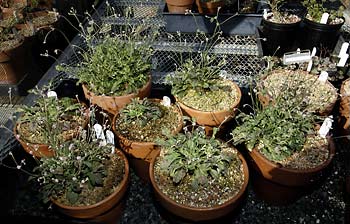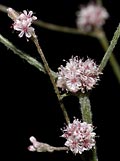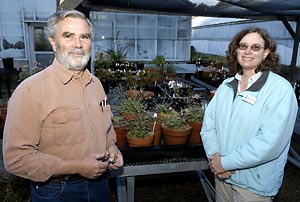UC Berkeley Press Release
Rare Mt. Diablo buckwheat flowers anew
BERKELEY – The future of a rare and dainty flower rediscovered a year ago on the slopes of Mount Diablo looks much rosier thanks to the successful germination of seeds from plants remaining in the wild.
  Rescued from extinction last year, the rare Mount Diablo buckwheat has now been propagated from wild seed at the UC Botanical Garden. These healthy specimens will be coddled until they produce seed, which will be collected and banked for further garden propagation and eventual reintroduction to the wilds of Mount Diablo. Rescued from extinction last year, the rare Mount Diablo buckwheat has now been propagated from wild seed at the UC Botanical Garden. These healthy specimens will be coddled until they produce seed, which will be collected and banked for further garden propagation and eventual reintroduction to the wilds of Mount Diablo.(Photos by Scott Hein/Save Mount Diablo) |
At a press conference today (Wednesday, June 7), the University of California Botanical Garden showed off one of the dozen new plants, most in pink flower, propagated in garden facilities. The seeds were collected last year by UC Berkeley graduate student Michael Park, who discovered the plant on May 10, 2005, and by Holly Forbes, curator and conservation officer at the garden.
"The Mount Diablo buckwheat is edging back from the brink of extinction, but it's still critically threatened," said Seth Adams, director of land programs for Save Mount Diablo, a conservation organization that preserved the land where the plant was rediscovered. "We held our breath until the wild plants showed up again, and all spring we've felt like proud parents as the first seeds sprouted and the botanical garden plants grew."
The flowering annual plant, called the Mount Diablo buckwheat, or Eriogonum truncatum, had last been seen in 1936 and was thought to be extinct. But last year, Park found a small patch of the buckwheat - one of only three plants endemic to the mountain - near a cow path on the southeast flank of the mountain, on land recently given to Mount Diablo State Park by Save Mount Diablo.
Park and UC Berkeley botanist Barbara Ertter, along with representatives of the California Department of Parks and Recreation and Save Mount Diablo, immediately announced the find and formed a group, the Mt. Diablo Buckwheat Working Group, to plan the plant's conservation. Both Ertter and Park are with the campus's University and Jepson Herbaria.
Since then, Park has visited the buckwheat breeding ground on Mount Diablo eight or nine times and set up two barriers to keep out careless cows and other animals. While he's not sure these "exclosures" did much more than collect weeds and debris, and one was kicked over by cows, he plans to keep the remaining one in place to increase chances of seeds sprouting.
There is some evidence, he noted, that the species needs minor disturbance to thrive. On an April 1 visit this spring, Park counted 90 plants, all near locations where plants were growing last year amidst native black sage. He weeded out introduced competitors - primarily wild oats, Italian rye grass and thistle - in the areas not caged, and on a return visit in May counted a peak population of just over 100 plants. On a June 6 visit, 69 plants were still growing while the others had produced seeds and died.
"Nearly a hundred plants came up in the area this winter, compared to fewer than 20 last year, but the number is less important to their survival than the amount of seeds the plants produce," Park said.
In order to protect the rare flower, which is considered critically threatened, according to Adams, access to the site has been limited and the location has not been revealed. And despite many field visits to Mount Diablo by Park and other botanists with photos of the plant, no additional Mount Diablo buckwheat specimens have been discovered.
Park pointed out that, with only one known population, the plant's survival is precarious, since a single cataclysmic event like a landslide could wipe it out entirely. Hence the need for conservation.
 UC Botanical Garden propagator John Domzalski and conservation director Holly Forbes with their new crop of Mount Diablo buckwheat. |
Last summer, after the wild plants had matured and died, Park and Forbes collected a few hundred seeds at the site, and this winter, UC Botanical Garden propagator John Domzalski successfully germinated a dozen - about a 12 percent success rate, according to Forbes. Most of the new plants are flowering, looking like a pink variety of Baby's Breath, each standing about eight inches tall with a six-inch diameter rosette of leaves at the base.
By continuing to propagate seeds from these cultivated plants and to gather more seeds from the wild for germination, Forbes hopes to bank enough seeds to sow more into the wild, perhaps by fall of 2007.
"We want to have enough seeds to be able to support the existing population and to start new ones in suitable sites," Forbes said.
"The Mount Diablo buckwheat is a Bay Area treasure," said Cyndy Shafer, an environmental scientist for the California Department of Parks and Recreation and leader of the Mt. Diablo Buckwheat Working Group. "The plants may be small, but they demonstrate the immense importance of protected lands in preserving biological diversity. Mount Diablo can be seen from 200 miles away, but the impact of this conservation success story inspires people all around the world."
Conservation efforts are numerous at the UC Botanical Garden, which is a member of the national Center for Plant Conservation, a network of botanical institutions dedicated to preventing the extinction of America's rare native plants. One international example is the garden's efforts to preserve cycads, an ancient group of palm-like plants, some of which have become very rare in their native habitats in South Africa.
"We're collaborating with South African colleagues to develop a stud bank of cycads," pollinating by hand what weevils do naturally in the wild, she said.
The garden's main conservation focus, however, is California plants. Nearly one in four native California plant species, many rare and endangered, are represented in the garden's collection, and the staff often works with state and other agencies to conserve endangered species.
"Here in the garden we are cultivating about 800 rare plants from around the world, and slightly more than 200 of them are native to California," Forbes said.
One example is the Baker's larkspur, or Delphinium bakeri, which is in even more peril than the buckwheat and was also in the news after being nearly destroyed by road work in Marin County.
Exactly one year ago today, the Mt. Diablo Buckwheat Working Group, which includes representatives of the UC Botanical Garden, California Department of Fish & Game, California Department of Parks & Recreation, California Native Plant Society, Save Mount Diablo, UC Berkeley Jepson Herbarium and U.S. Fish & Wildlife Service, along with the plant's rediscoverer, Michael Park, was convened.

